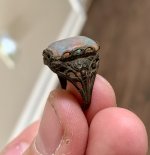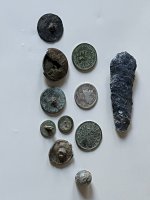WHADIFIND
Gold Member
I've always wanted to just toss these two questions out there and see what I "catch". 
The first is really general and I'm still trying to figure out best practices with this new-fangled ATP of mine. I've been hunting for 2 years and pretty much have it figured out. Except, for manual ground balancing. I usually just let the machine figure out where it's happy. But, I know some fine tune that balancing. I just don't understand the theory. What is gained/lost by changing the machine's tuning to a few points higher or lower?
The 2nd one is more about chemistry and experience. I have had the good fortune to be hunting in the 70's and again, now in this new millennium. I have found just about every type of coin this time around as I did in the beginning. Of course, they're a lot fewer nowadays as there's been so many hunting in the meantime.
My question: Is there an age boundary for coins like copper/brass/bronze? What I mean is, will these metals start deteriorating worse after a certain time? The reason I ask is that I have found many wonderful coins that look like they came from the bank and were buried the same day. Oh sure, they have the solid green patina but ALL of the detail is there! (on some of them) Almost NONE of the ones I've found this time around, (almost 50 years later on), seem to be in much shape at all.
Now, I know this is completely dependent on the type of soil. But, is there a certain amount of time where the metals themselves just kind of give up the ghost? So to speak. Like lead turns white after about 100 years does copper/bronze sort of just start crumbling or some such? I'm beginning to think that we are running out of time to find any of these coins in decent shape anymore.
Thoughts?
And thanks for reading!

The first is really general and I'm still trying to figure out best practices with this new-fangled ATP of mine. I've been hunting for 2 years and pretty much have it figured out. Except, for manual ground balancing. I usually just let the machine figure out where it's happy. But, I know some fine tune that balancing. I just don't understand the theory. What is gained/lost by changing the machine's tuning to a few points higher or lower?
The 2nd one is more about chemistry and experience. I have had the good fortune to be hunting in the 70's and again, now in this new millennium. I have found just about every type of coin this time around as I did in the beginning. Of course, they're a lot fewer nowadays as there's been so many hunting in the meantime.
My question: Is there an age boundary for coins like copper/brass/bronze? What I mean is, will these metals start deteriorating worse after a certain time? The reason I ask is that I have found many wonderful coins that look like they came from the bank and were buried the same day. Oh sure, they have the solid green patina but ALL of the detail is there! (on some of them) Almost NONE of the ones I've found this time around, (almost 50 years later on), seem to be in much shape at all.
Now, I know this is completely dependent on the type of soil. But, is there a certain amount of time where the metals themselves just kind of give up the ghost? So to speak. Like lead turns white after about 100 years does copper/bronze sort of just start crumbling or some such? I'm beginning to think that we are running out of time to find any of these coins in decent shape anymore.
Thoughts?
And thanks for reading!
Last edited:








